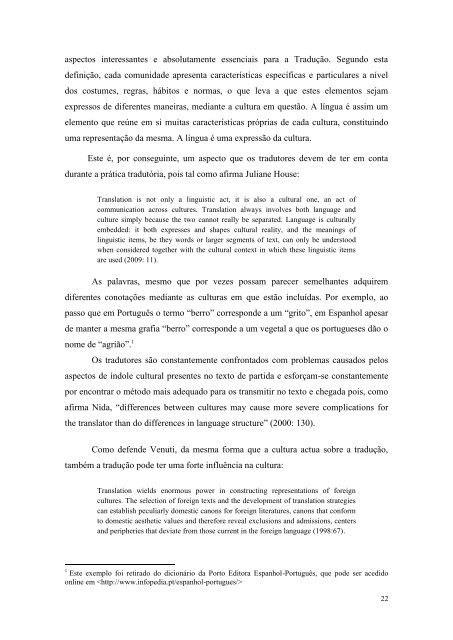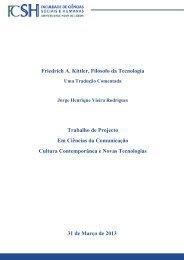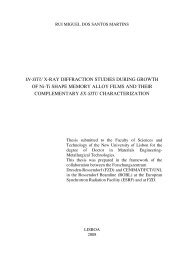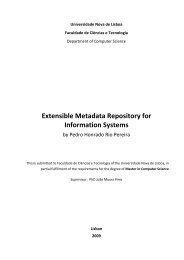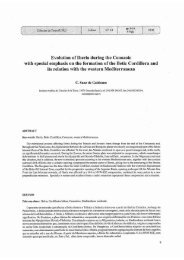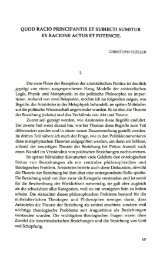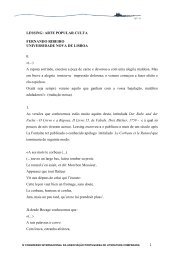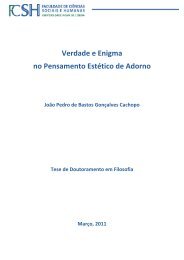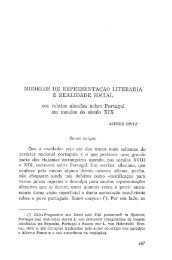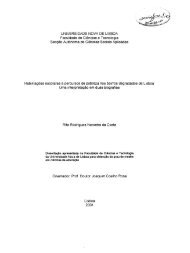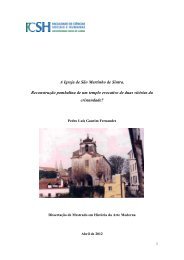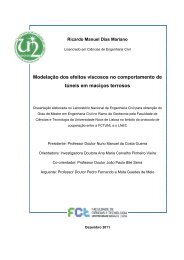A Tradução é um Lugar Estranho: Comunicação ... - RUN UNL
A Tradução é um Lugar Estranho: Comunicação ... - RUN UNL
A Tradução é um Lugar Estranho: Comunicação ... - RUN UNL
You also want an ePaper? Increase the reach of your titles
YUMPU automatically turns print PDFs into web optimized ePapers that Google loves.
aspectos interessantes e absolutamente essenciais para a Tradução. Segundo esta<br />
definição, cada comunidade apresenta características específicas e particulares a nível<br />
dos cost<strong>um</strong>es, regras, hábitos e normas, o que leva a que estes elementos sejam<br />
expressos de diferentes maneiras, mediante a cultura em questão. A língua é assim <strong>um</strong><br />
elemento que reúne em si muitas características próprias de cada cultura, constituindo<br />
<strong>um</strong>a representação da mesma. A língua é <strong>um</strong>a expressão da cultura.<br />
Este é, por conseguinte, <strong>um</strong> aspecto que os tradutores devem de ter em conta<br />
durante a prática tradutória, pois tal como afirma Juliane House:<br />
Translation is not only a linguistic act, it is also a cultural one, an act of<br />
communication across cultures. Translation always involves both language and<br />
culture simply because the two cannot really be separated. Language is culturally<br />
embedded: it both expresses and shapes cultural reality, and the meanings of<br />
linguistic items, be they words or larger segments of text, can only be understood<br />
when considered together with the cultural context in which these linguistic items<br />
are used (2009: 11).<br />
As palavras, mesmo que por vezes possam parecer semelhantes adquirem<br />
diferentes conotações mediante as culturas em que estão incluídas. Por exemplo, ao<br />
passo que em Português o termo “berro” corresponde a <strong>um</strong> “grito”, em Espanhol apesar<br />
de manter a mesma grafia “berro” corresponde a <strong>um</strong> vegetal a que os portugueses dão o<br />
nome de “agrião”. 1<br />
Os tradutores são constantemente confrontados com problemas causados pelos<br />
aspectos de índole cultural presentes no texto de partida e esforçam-se constantemente<br />
por encontrar o método mais adequado para os transmitir no texto e chegada pois, como<br />
afirma Nida, “differences between cultures may cause more severe complications for<br />
the translator than do differences in language structure” (2000: 130).<br />
Como defende Venuti, da mesma forma que a cultura actua sobre a tradução,<br />
também a tradução pode ter <strong>um</strong>a forte influência na cultura:<br />
Translation wields enormous power in constructing representations of foreign<br />
cultures. The selection of foreign texts and the development of translation strategies<br />
can establish peculiarly domestic canons for foreign literatures, canons that conform<br />
to domestic aesthetic values and therefore reveal exclusions and admissions, centers<br />
and peripheries that deviate from those current in the foreign language (1998:67).<br />
1 Este exemplo foi retirado do dicionário da Porto Editora Espanhol-Português, que pode ser acedido<br />
online em <br />
22


